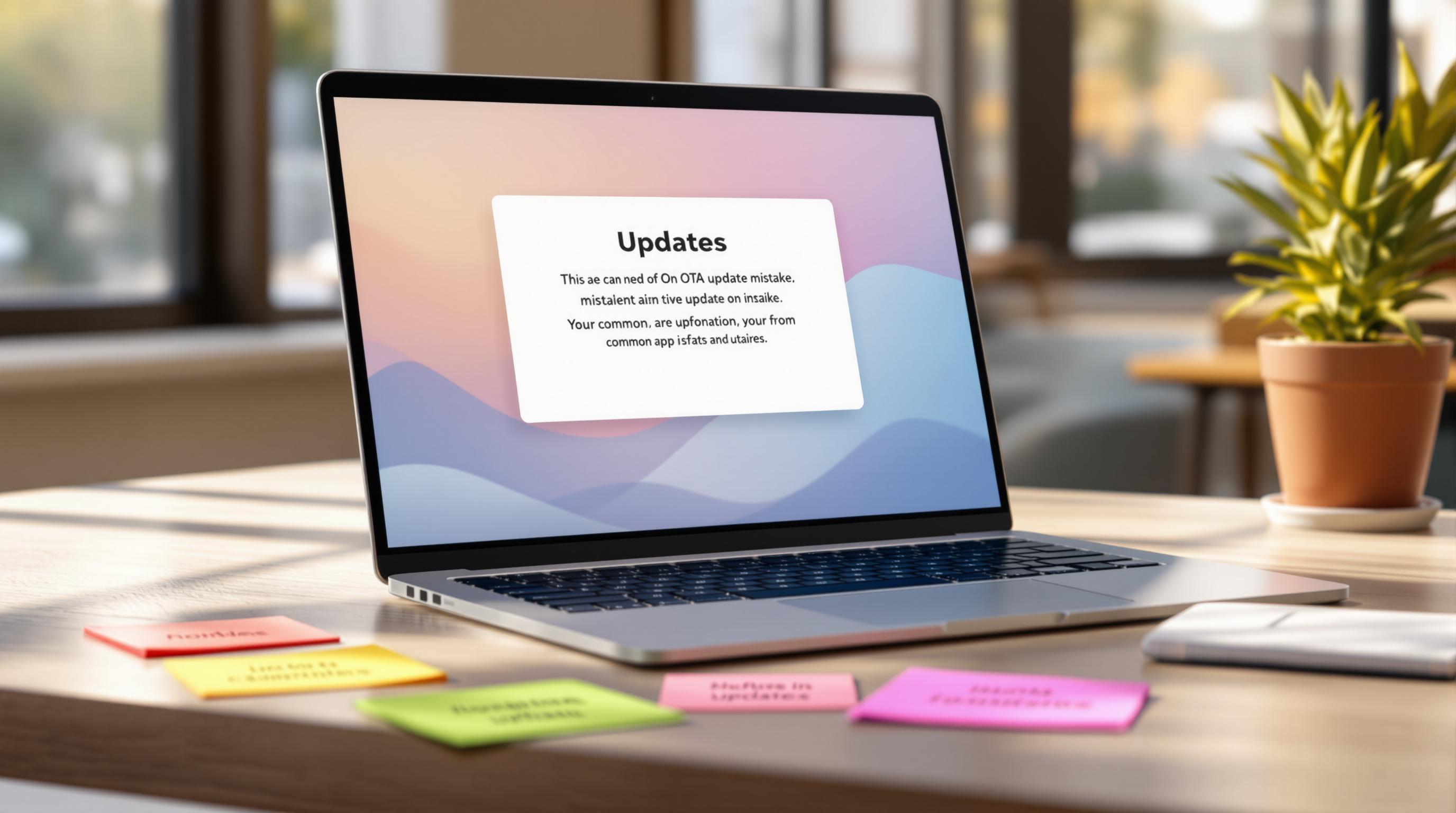Handling user data in Capacitor apps requires secure storage, clear retention policies, and compliance with data protection laws like GDPR and CCPA. This guide explains how to minimize data collection, secure sensitive information, and manage permissions effectively. Here’s a quick overview:
- Data Minimization: Collect only what’s necessary for specific app features.
- Secure Storage: Use tools like the
@capacitor/secure-storageplugin for encryption. - Data Retention: Automate deletion based on defined time limits.
- User Rights: Enable users to access, delete, or export their data.
- Permission Management: Request permissions contextually and provide alternatives for denied requests.
- OTA Updates: Ensure secure over-the-air updates with tools like Capgo.
How to use Ionic Capacitor Secure Storage

Reducing Data Collection
Taking a structured approach to reviewing, planning, and managing data collection is key to staying compliant with privacy regulations. By leveraging Capacitor’s built-in tools for minimizing data collection, you can take practical steps to improve your app’s data practices.
Data Collection Review
Start by mapping out how data flows through your app. Use tools like data lineage visualizers to spot areas where unnecessary data might be collected. Privacy Impact Assessment (PIA) software can guide you in assessing whether each piece of data is truly needed. Here’s a breakdown of areas to focus on:
| Data Type | Review Focus | Action Items |
|---|---|---|
| User Input | Form fields and validation | Remove fields that aren’t needed |
| API Calls | Request/response payloads | Filter out extra data fields |
| Storage | Cached and persistent data | Streamline storage usage |
| Analytics | Usage tracking | Keep only essential metrics |
Data Collection Goals
Be clear about why you’re collecting each piece of data. Every data point should serve a specific purpose. For example:
// Purpose-driven data collection exampleconst userPreferences = { location: "Used for local weather updates", notification: "Needed for sending alerts"};If your app has a weather feature, it might only require a zip code rather than a full address. This approach ensures you’re gathering only the information necessary for core app functions[1][5].
Data Input Controls
Use validation tools to limit the amount of data collected through forms and API calls. Combine client-side validation with server-side verification to enforce these limits effectively.
Incorporate Capacitor’s security features to enhance these controls:
- Use dropdown menus instead of free-text fields where possible.
- Set character limits for text input fields.
Schedule quarterly audits with automated discovery tools to ensure your data collection practices remain efficient and aligned with your app’s intended functionality.
Data Security and Storage
Once you’ve defined your data collection boundaries, it’s crucial to implement measures to safeguard user information while adhering to data minimization principles.
Setting Up Secure Storage
The @capacitor/secure-storage plugin uses built-in security features like iOS Keychain and Android Keystore to protect sensitive data [1].
import { SecureStorage } from '@capacitor/secure-storage';
// Store sensitive dataawait SecureStorage.set({ key: 'authToken', value: 'user-specific-token'});
// Retrieve stored dataconst { value } = await SecureStorage.get({ key: 'authToken' });Data Encryption Methods
Adding client-side encryption is another layer of protection. Libraries like CryptoJS can help encrypt sensitive information:
// Basic encryption/decryption implementationconst encryptData = (data: string, key: string): string => { return CryptoJS.AES.encrypt(data, key).toString();};Rotating encryption keys regularly is a smart way to improve security. This ensures that even if one key is compromised, the rest of the data stays secure [2].
Comparing Storage Options
Selecting the right storage solution depends on how sensitive the data is. Here’s a quick comparison:
| Feature | Secure Storage | Local Storage |
|---|---|---|
| Security Level | High (encrypted) | Basic |
| Best For | Tokens, passwords | Non-sensitive settings |
| Performance | Slower (due to encryption) | Faster access |
The Secure Storage API is a solid choice for storing critical information like authentication tokens and personal user data [1][4]. Its encryption capabilities also align with retention policies, allowing controlled access to data within specified timeframes [2].
sbb-itb-f9944d2
Data Storage Time Limits
Setting clear data retention policies helps align with data minimization principles, ensuring information isn’t kept longer than necessary.
Storage Time Rules
Different types of user data should have defined retention periods based on their purpose and level of sensitivity. Below is a suggested framework for managing data retention in Capacitor apps:
| Data Type | Retention Period | Justification |
|---|---|---|
| Account Data | Until account deletion or 2 years of inactivity | Needed for account-related operations |
| Transaction Records | 7 years | Compliance with financial regulations |
| Analytics Data | 90 days (anonymized), 1 year (deletion) | Supports feature improvements |
| Marketing Preferences | Until opt-out or account deletion | Adheres to consent requirements |
Here’s an example of how to store data with an expiration date programmatically:
async function storeDataWithExpiration(key: string, value: any, retentionDays: number) { const item = { value: value, expiration: Date.now() + (retentionDays * 24 * 60 * 60 * 1000) }; await Preferences.set({ key, value: JSON.stringify(item) });}Automatic Data Removal
Automating data cleanup can help maintain compliance and reduce manual intervention. Capacitor’s background fetch feature is a useful tool for this:
import { BackgroundFetch } from '@capacitor/background-fetch';
BackgroundFetch.registerTask({ taskId: 'data-cleanup', delay: 3600000, periodic: true, requiresNetworkConnectivity: false}, async () => { await cleanExpiredData(); return BackgroundFetch.Result.NewData;});If you’re using SQLite for storage, you can set up triggers to automatically delete expired records:
CREATE TRIGGER remove_expired_dataAFTER INSERT ON user_dataBEGIN DELETE FROM user_data WHERE expiration_date < CURRENT_TIMESTAMP;END;User Data Removal Options
Providing users with tools to manage their data is essential. Here are two key features you can implement:
- Delete Specific Data: Allow users to remove certain data types tied to their account.
async function deleteSpecificData(userId: string, dataType: string) { await Preferences.remove({ key: `${userId}_${dataType}` });
if (db) { await db.run( 'DELETE FROM user_data WHERE user_id = ? AND data_type = ?', [userId, dataType] ); }}- Export User Data: Enable users to download their stored data in a structured format.
async function exportUserData(userId: string) { // Gathers all user data for export const userData = await collectUserData(userId); return JSON.stringify(userData);}The French data protection authority CNIL highlights that retention periods must align with the core functionality of the app [3]. This principle is particularly relevant for Capacitor app developers and should guide your data retention strategy.
App Permissions Control
Handling app permissions carefully is key to safeguarding user data while ensuring your app functions as intended. By managing permissions properly, you can limit access to only the device features your app truly needs. Capacitor’s Permissions API offers a unified approach to managing permissions on both iOS and Android.
Permission Request Steps
Make sure the permissions you request align with your app’s data collection goals. Here’s a sample implementation for handling permission requests in a Capacitor app:
import { Permissions } from '@capacitor/core';
const permissionHandler = async (permissionType: string) => { const status = await Permissions.query({ name: permissionType });
if (status.state === 'granted') { return true; }
const shouldProceed = await showExplanationDialog( `We need ${permissionType} access to provide core functionality` );
if (shouldProceed) { const result = await Permissions.request({ name: permissionType }); return result.state === 'granted'; }
return false;};Managing Denied Permissions
If a user denies a permission request, provide clear alternatives and guidance. Here’s an example:
const handleDeniedPermission = async (permissionType: string) => { const status = await Permissions.query({ name: permissionType });
if (status.state === 'denied') { const alternatives = { camera: 'manual photo upload', location: 'manual address entry', notifications: 'in-app message center' };
showAlternativeFeature(alternatives[permissionType]);
if (status.canOpenSettings) { offerSettingsRedirect(); } }};Timing Permission Requests
When you ask for permissions matters. Strategic timing can significantly improve user acceptance rates. Here’s a quick breakdown of timing strategies:
| Timing Strategy | Best Use Case |
|---|---|
| Just-in-Time | For specific features when needed |
| Contextual | For non-critical features |
| First Launch | For core features required upfront |
| Delayed | For optional features later in the user journey |
For example, you can request camera access only when the user initiates an action like taking a photo:
const captureImage = async () => { const userStartedCapture = true;
if (userStartedCapture) { const granted = await permissionHandler('camera');
if (granted) { await startCamera(); } else { showUploadOption(); } }};Contextual requests like this can boost acceptance rates by 50% compared to upfront requests [2]. To ensure a smooth experience, maintain a permission state tracker that saves user decisions across sessions.
Once permissions are handled, you can shift focus to securing updates, especially for over-the-air (OTA) deployments.
OTA Update Security
To ensure data integrity during app updates, it’s crucial to use secure OTA (Over-The-Air) update processes. These updates help prevent unauthorized changes to app code, which could otherwise bypass limits on data collection.
Update Package Signing
Signing update packages is a critical step in protecting against unauthorized code changes. Here are some key measures to secure OTA updates:
| Security Measure | How It’s Done |
|---|---|
| Content Protection | AES encryption |
| Delivery Security | HTTPS with certificate pinning |
| Update Integrity | Hash verification |
| Version Safety | Signed version numbers |
| Failure Recovery | Instant rollback capability |
Capgo Update System

Capgo simplifies secure OTA updates for Capacitor apps by offering automated security features. Here’s an example of how to use Capgo’s update system in your app:
import { CapacitorUpdater } from '@capgo/capacitor-updater';
const secureUpdate = async () => { try { const update = await CapacitorUpdater.download({ version: 'latest', validateSignature: true }); if (update.status === 'success') { await CapacitorUpdater.set(update); } } catch (error) { await CapacitorUpdater.rollback(); }};This approach ensures updates are validated and secure, with rollback options in case of failure.
Store Policy Compliance
Adhering to app store guidelines is necessary for OTA updates[1][6][7]. Each platform has specific requirements to ensure updates align with their data retention and security policies:
| Platform | Compliance Requirements |
|---|---|
| iOS | Only JavaScript or asset updates |
| Android | User consent must be obtained |
| Both | Security checks and proper documentation |
Below is an example of implementing store-compliant updates:
const compliantUpdate = async () => { const userConsent = await requestUpdateConsent(); if (userConsent) { await CapacitorUpdater.setUpdateConfig({ type: 'assets-only', scope: 'ui-updates' // Updates limited to UI components }); }};
const preventDowngrade = async (newVersion, currentVersion) => { const versions = await CapacitorUpdater.getVersions(); if (versions.current.buildNumber > newVersion.buildNumber) { throw new Error('Downgrade attempt detected'); }};Summary
Key Takeaways
Handling user data effectively involves combining these core strategies:
- Collect only the necessary data.
- Use platform-native encryption to safeguard it.
- Automate data retention deadlines.
- Set up detailed permission controls.
These steps work together to ensure compliance from the moment data is collected until it’s automatically deleted.
Steps to Implement
To put these strategies into action:
- Audit your data flows using the methods discussed in section 2.
- Strengthen storage security as outlined in section 3.
- Set up automated deletion processes based on section 4.
- Establish and enforce permission controls detailed in section 5.
Leveraging Capgo
For teams managing OTA updates, Capgo offers built-in security tools that align with these efforts:
- End-to-end encryption to secure update packages.
- Real-time monitoring for quickly addressing potential security threats.




